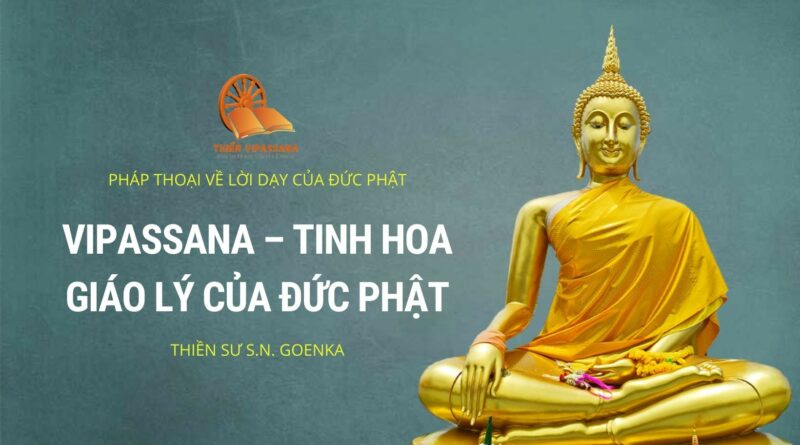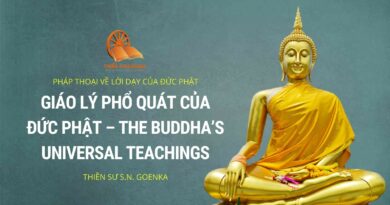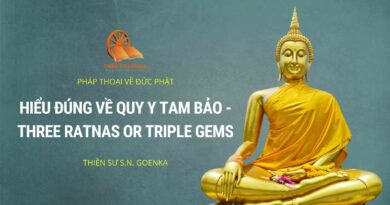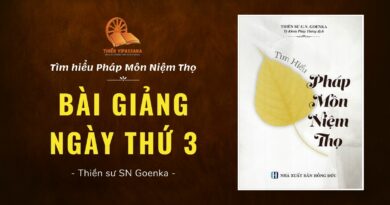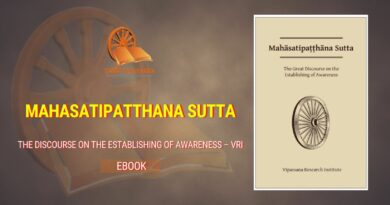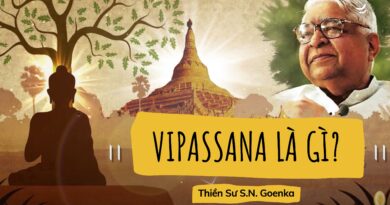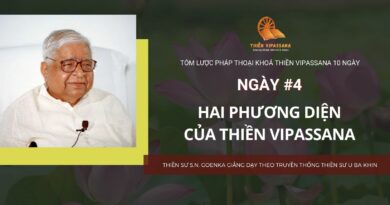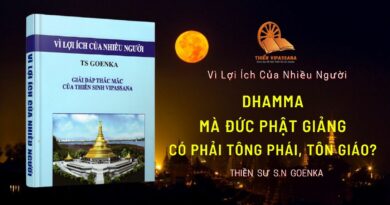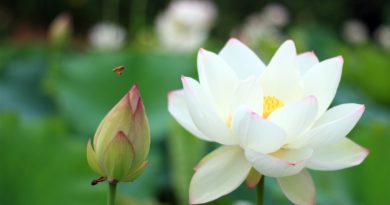Vipassana – quintessence of the Buddha’s Teachings – Vipassana – tinh hoa giáo lý của Đức Phật
Vipassana, the practical quintessence of the teaching of the Buddha, is not merely a theory or philosophy for any kind of intellectual entertainment and philosophical discussion, nor an emotional or devotional game. It is down-to-earth, practical, rational, scientific, non-sectarian and result-oriented. Vipassana can be practiced and is practiced by one and all.
Vipassana, tinh hoa trong giáo lý của Đức Phật, không chỉ đơn thuần là một lý thuyết hay triết lý cho bất kỳ loại hình giải trí ở cấp độ trí tuệ hay thảo luận triết học nào, cũng không phải là một trò chơi cảm xúc hay sùng bái nào. Đó là một phương pháp thực tế, lô-gic, có khoa học, không giáo phái và hướng đến kết quả. Vipassana là dành cho tất cả mọi người.
Practicing Vipassana makes one a good human being, enables one to live a peaceful and harmonious life, and helps generate a peaceful and harmonious atmosphere all around oneself for others. Which religion in the world will object to this conversion from disharmony to harmony?
Thực hành Vipassana giúp một người trở nên tốt hơn, cho phép họ sống một cuộc sống bình an và hài hòa, cũng như tạo ra bầu không khí chan hòa với những điều xung quanh. Tôn giáo nào trên thế giới phản đối sự chuyển đổi từ bất bình sang hòa hợp?
There is nothing objectionable in practicing the technique of concentration of the mind by observing one’s natural, normal respiration, without adding any sectarian verbalization, or any visualization, imagination etc. Which religion can object to observing one’s natural respiration? Respiration is universal. Similarly, nobody objects to purifying one’s mind at the deepest level, by objectively observing the interaction of mind and matter within oneself, at the level of body sensations, which again is universal. The body sensations arise when the mind and matter interact with each other, every moment of one’s life.
Không có cớ gì để phản đối một kỹ thuật giúp định tâm bằng cách quan sát hơi thở tự nhiên, bình thường của một người, mà không có sự can thiệp từ bất cứ lời nói, sự hình dung, trí tưởng tượng của giáo phái nào. Tôn giáo nào có thể phản đối việc quan sát hơi thở tự nhiên của một người? Hơi thở là phổ quát. Tương tự như vậy, không ai phản đối việc thanh lọc tâm trí của một người ở cấp độ sâu nhất, bằng cách quan sát khách quan phản ứng của tâm trí với cơ thể ở mức độ cảm giác trên thân, điều này một lần nữa là phổ quát. Các cảm giác cơ thể nảy sinh khi tâm trí và vật chất tương tác với nhau trong mọi khoảnh khắc trôi qua.
By practicing Vipassana, one experiences how the mind and body keep influencing each other. Without experiencing this truth, one continuously reacts to the feeling of bodily sensations created by mind-matter interaction. One also remains ignorant how, at the root level of the mind, one keeps on generating craving towards pleasant sensations and aversion towards unpleasant sensations. This is the defilement of the mind that arises and gives support to its habit pattern at its deepest level. Observing this phenomenon objectively, without reaction, one comes out of the old habit pattern of generating ‘raga’ and ‘dwesha’ (craving and aversion) towards them.
Bằng cách thực hành Vipassana, người ta hiểu được cách tâm trí và cơ thể tác động lẫn nhau. Nếu không kinh nghiệm được sự thật này, người ta liên tục phản ứng với cảm giác trên cơ thể được tạo ra bởi sự tương tác giữa vật chất và tinh thần. Người ta vẫn không biết tại sao ở sâu trong tâm trí, liên tục tạo ra sự thèm muốn đối những cảm giác dễ chịu và sự ghét bỏ những cảm giác khó chịu. Đây là sự ô uế của tâm khởi sinh và là nô lệ cho mô thức thói quen cũ ở cấp độ sâu nhất của tâm. Khi quan sát phản ứng này một cách khách quan, khi không có phản ứng, người ta sẽ thoát ra khỏi mô thức thói quen cũ là sinh ra ‘raga’ và ‘dwesha’ (tham ái và ghét bỏ).
Apparent Reality and Actuality – Chứng nghiệm Thực Tế và Sự thật
At the apparent level, it seems one is reacting with craving and aversion to the respective objects of the six sense doors – a colour, shape, or light at the eye sense door, a sound at the ear, a taste at the tongue, a smell at the nose, something tangible at the body sense door, a thought at the mind sense door.
Ở cấp độ sự thật, dường như người ta đang phản ứng với sự thèm muốn và ghét bỏ với các đối tượng tương ứng của 6 trần cảnh – hình sắc, âm thanh, mùi hương, vị ngon, xúc chạm, pháp trần thông qua 6 giác quan – mắt, tai, mũi, lưỡi, thân và ý.
The Buddha discovered reality at the actual level. He found that with contact of sensual objects with the sense doors, i.e. salayatana paccaya phasso, there is a feeling of sensation on the body, i.e. phassa paccaya vedana. And it is to this feeling of sensation within that one is reacting with craving or aversion, i.e. vedana paccaya tanha. This is the reality at the actual level. And the Enlightened One gave the technique of Vipassana that works at this actual level.
Đức Phật đã khám phá ra sự thật ở cấp độ trải nghiệm. Ngài phát hiện ra rằng với sự tiếp xúc của các đối tượng gợi cảm với các trần cảnh, tức là salayatana paccaya phasso, khi đó sẽ có một cảm giác trên cơ thể, tức là phass paccaya vedana. Và đó chính là cảm giác khởi sinh khi tâm phản ứng với sự thèm muốn hoặc ác cảm, tức là vedana paccaya tanha. Đây là sự thật ở cấp độ trải nghiệm. Và Bậc giác ngộ đã đưa ra kỹ thuật Vipassana – để ta có thể làm việc trên cấp độ kinh nghiệm.
Observing the feeling of sensation in the body makes it very obvious that one cannot harm another being without generating a defilement in the mind: one cannot kill a fellow being without generating animosity, one cannot steal without generating greed or craving, one cannot commit rape or adultery without generating lust or passion. And so also one cannot commit any wrong vocal action without generating some defilement in the mind.
Việc quan sát cảm giác trên thân cho thấy rất rõ rằng người ta không thể làm hại người khác mà không tạo ra phiền não: người ta không thể giết đồng loại mà không sinh ra thù oán, người ta không thể đánh cắp mà không tạo ra lòng tham hay tham ái, người ta không thể hiếp dâm hoặc ngoại tình mà không tạo ra ham muốn hay đam mê. Và do đó, người ta không thể thực hiện bất kỳ lời nói sai trái nào mà không tạo ra một số phiền não trong tâm trí.
Very importantly, Vipassana helps one experience a deeper necessity to be free from every defilement and to maintain perfect sila. Initially, yes, one accepts the need to maintain sila out of concern for others, or concern for the laws of the land. But with Vipassana, one experiences the laws of Dhamma. Just as the benefits of following the laws of Dhamma are here and now, the punishment for breaking the laws of Dhamma is here and now.
Một điều quan trọng, Vipassana giúp một người trải nghiệm được sự cần thiết để thoát khỏi mọi phiền não và duy trì sila (giới) hoàn hảo. Ban đầu, ta chấp nhận việc duy trì sila vì lo lắng cho người khác, hoặc vì tuân theo luật pháp của nước nhà. Nhưng với Vipassana, ta trải nghiệm quy luật của Dhamma. Cũng giống như thời điểm hưởng lợi ích của việc tuân theo Dhamma là ngay bây giờ, thời điểm chịu hình phạt cho việc vi phạm Dhamma là ngay tức khắc.
The very instant one breaks sila one starts feeling miserable. By generating any defilement like anger, hatred, ill will, animosity etc. one immediately becomes agitated and loses the peace, balance and harmony of one’s mind. The person at whom the defilement is directed is harmed only later. But the first victim is oneself. By experiencing this reality, one realizes the necessity to come out of every defilement of the mind. One starts maintaining perfect sila, for one’s own benefit, to come out of misery.
Ngay khoảnh khắc một người phá vỡ sila, họ sẽ lập tức cảm thấy đau khổ. Bằng cách tạo ra bất kỳ phiền não nào như giận dữ, hận thù, ác ý, thù địch, v.v … người ta ngay lập tức trở nên kích động và mất đi sự bình yên, cân bằng và hài hòa trong tâm trí. Sự ô uế trong tâm trí của họ lập tức khởi sinh. Nạn nhân đầu tiên là chính bản thân ta. Bằng cách trải nghiệm thực tế này, ta nhận ra sự cần thiết để thoát ra khỏi mọi ô uế của tâm trí. Người ta bắt đầu duy trì sila hoàn hảo, vì lợi ích của chính mình, thoát khỏi cảnh khốn cùng.
It is only by direct experience that the teaching of the Enlightened One becomes so clear:
Chỉ bằng kinh nghiệm trực tiếp, giáo huấn của Đấng giác ngộ mới trở nên rõ ràng:
‘Pubbe hanati attanam, paccha hanati so pare’
– Unless one develops the ability to experience the reality within oneself, one keeps on generating defilement after defilement, and harming oneself. With Vipassana, one breaks the habit pattern of the mind to generate defilements at the root level of the mind. The roots of defilement are cut. There comes a time when that tree of defilement cannot grow again.
– Trừ phi ta phát triển khả năng chứng nghiệm sự thực trong chính mình, ta sẽ tiếp tục tạo ra phiền não và làm hại chính mình. Với Vipassana, ta phá vỡ mô thức thói quen của tâm trí tạo ra phiền não ở tầng sâu thẳm của tâm trí. Rễ của phiền não bị cắt bỏ. Đã có lúc cây ô uế không thể mọc lại.
The Buddha made another invaluable discovery. He found that anything arising in the mind, starts flowing with the feeling of sensation in the body: Vedana Samosarana Sabbe Dhamma.
Đức Phật đã có một khám phá vô giá khác. Ngài thấy rằng bất cứ điều gì khởi sinh trong tâm trí, đều dẫn đến cảm giác trên cơ thể: Vedana Samosarana Sabbe Dhamma.
Those who are slaves of the habit pattern of generating misery – by generating anger, or passion, or ego etc. – learn how to eliminate this misery by observing the feeling of sensation in the body, at the very moment a defilement arises in the mind. Similarly, people suffering from feelings of depression, fear, insecurity, inferiority complex etc. also easily come out of all these complexes by objectively observing the feeling of sensations in the body, when such defilements arise.
Những người là nô lệ của thói quen tạo ra đau khổ – bằng cách sinh ra tức giận, đam mê, hoặc bản ngã, v.v. – cần loại bỏ sự khốn khổ này bằng cách quan sát cảm giác trên thân, ngay lúc sự ô uế xuất hiện trong tâm trí. Tương tự, những người mắc chứng trầm cảm, sợ hãi, bất an, lo âu, v.v … cũng dễ dàng thoát ra bằng cách quan sát khách quan cảm giác trên cơ thể khi chúng xuất hiện.
A large number of people also take Vipassana courses to come out of addictions to different intoxicants. They very soon understand that their actual addiction is not towards the intoxicant, but to the sensation that one feels in the body by taking the intoxicant. By the practice of Vipassana, they learn not to react to body sensations, but to observe it objectively, with perfect equanimity, perfect equilibrium of the mind. Thus, the habit pattern of the mind starts getting broken and one comes out of any addiction easily.
Nhiều người tham gia các khóa thiền Vipassana với mục đích thoát khỏi cảm giác nghiện các chất gây hại. Họ sớm hiểu rằng thực tế nghiện không đến từ chất gây ra nghiện mà là cảm giác khởi sinh khi dùng các chất gây nghiện đó. Bằng cách thực hành Vipassana, họ học cách không phản ứng với cảm giác cơ thể, mà quan sát nó một cách khách quan, với sự quân bình, trạng thái cân bằng hoàn hảo của tâm trí. Do đó, mô thức thói quen của tâm trí bắt đầu bị phá vỡ và người ta thoát khỏi bất kỳ cơn nghiện nào một cách dễ dàng.
VRIDhamma.org

